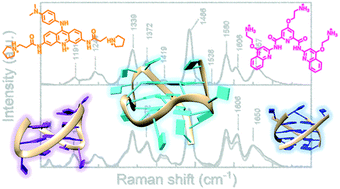Ligand binding to G-quadruplex DNA: new insights from ultraviolet resonance Raman spectroscopy†
Abstract
G-Quadruplexes (G4s) are noncanonical nucleic acid structures involved in the regulation of several biological processes of many organisms. The rational design of G4-targeting molecules developed as potential anticancer and antiviral therapeutics is a complex problem intrinsically due to the structural polymorphism of these peculiar DNA structures. The aim of the present work is to show how Ultraviolet Resonance Raman (UVRR) spectroscopy can complement other techniques in providing valuable information about ligand/G4 interactions in solution. Here, the binding of BRACO-19 and Pyridostatin – two of the most potent ligands – to selected biologically relevant G4s was investigated by polarized UVRR scattering at 266 nm. The results give new insights into the binding mode of these ligands to G4s having different sequences and topologies by performing an accurate analysis of peaks assigned to specific groups and their changes upon binding. Indeed, the UVRR data not only show that BRACO-19 and Pyridostatin interact with different G4 sites, but also shed light on the ligand and G4 chemical groups really involved in the interaction. In addition, UVRR results complemented by circular dichroism data clearly indicate that the binding mode of a ligand can also depend on the conformation(s) of the target G4. Overall, these findings demonstrate the utility of using UVRR spectroscopy in the investigation of G4s and G4–ligand interactions in solution.



 Please wait while we load your content...
Please wait while we load your content...